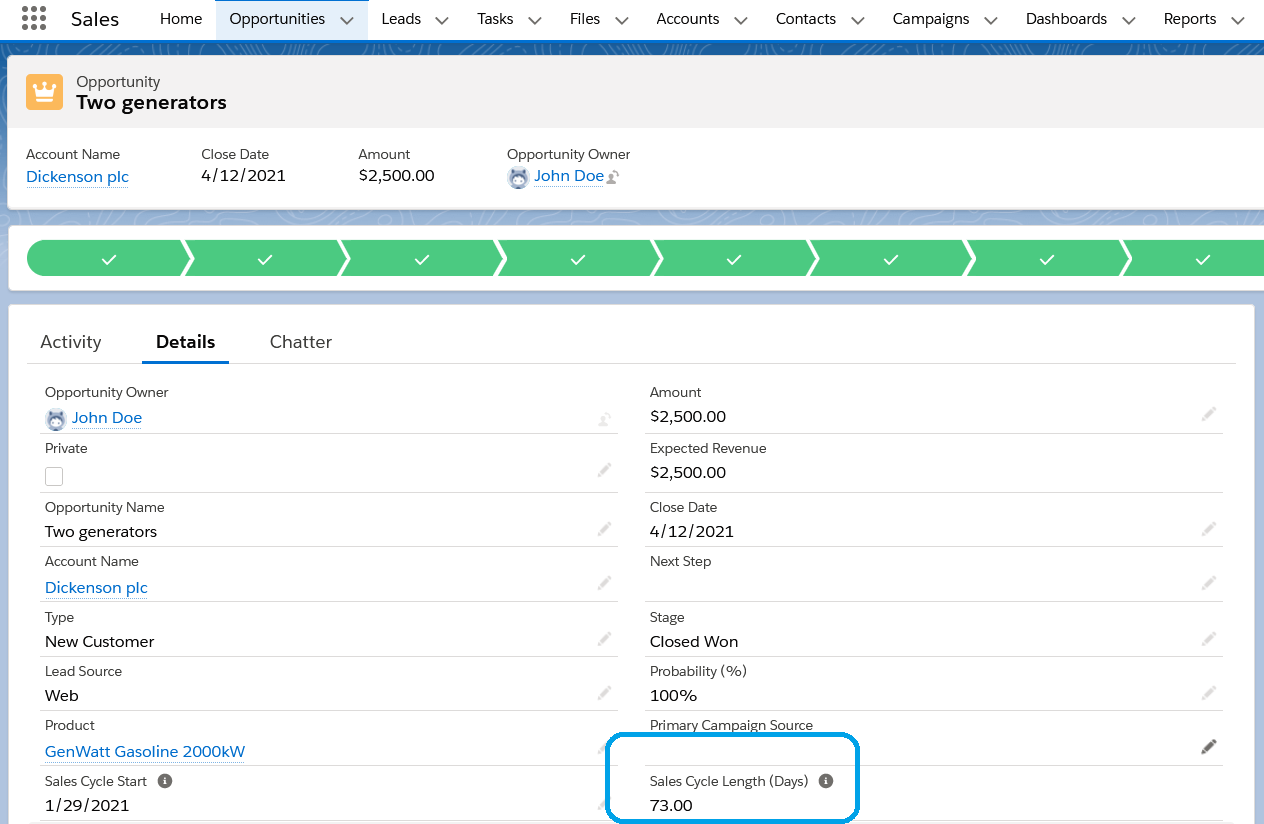Measuring Sales Cycle Length in Salesforce
Accurately measuring sales cycle length is crucial for virtually all types of businesses. A sales cycle is a series of activities and events occurring while selling a product.
While individual activities may vary for each sale, they are typically grouped into stages such as prospecting, qualification, product demo/presentation, quoting, objection handling, closure, and more. The specific stages depend on how a business structures its sales process.
Sales cycle length refers to the time taken from the initial “first touch” with a prospect to “closing the deal”. It measures how long it takes to win the business and sell the product.
The average sales cycle length is one of the most important business KPIs, typically reported by product type, sales representative, or other business-specific criteria.
While there is common agreement on when a deal is closed (e.g., customer signature or order date), the definition of the “first touch” can vary. It may include:
- Date when a lead was created,
- Date of the first event with the lead (intro call, email),
- A sales stage change: opportunity was qualified, product presented, quote sent, etc.
This post provides options for accurate sales cycle measurements in Salesforce.
Using Built-In Opportunity Age
Most CRM systems allow reporting on opportunity “age”. For example, Salesforce offers age field working as follows:
if (Opportunity is closed) return Close Date - Created Date else return Today - Created Date
There are two problems with this approach:
- The age field is available only in reports but not in list views, triggers, etc.
- Once the opportunity has been entered, the creation date cannot be modified — therefore reporting is dependent on timely opportunity creation by sales reps*
* Technically creation date can be changed by exporting, deleting and re-importing opportunities but that is not practically viable option.
Adding Custom Opportunity Fields
To remedy creation date limitations, a custom Sales_Cycle_Start field can be added:
- Typically, a sales cycle will be measured in days which implies Date rather than DateTime as the field type
- The default value is TODAY() so it mimics CreatedDate behavior
- Depending on who is allowed to adjust it, access can be granted to system administrators or sales reps/opportunity owners
Now that the sales cycle start is available, its length can be calculated using the following formula:
IF( IF( IsClosed, CloseDate - Sales_Cycle_Start__c, TODAY() - Sales_Cycle_Start__c ) < 1, 1, /* round up to one day */ IF( IsClosed, CloseDate - Sales_Cycle_Start__c, TODAY() - Sales_Cycle_Start__c ) )
The new fields can be added to the Salesforce opportunity layout:

Alternatives for Determining the Beginning of the Sales Cycle
In the example above, start of the sales cycle is based on the creation of the opportunity (with possible adjustment afterwards).
However, some businesses may choose a different way of establishing when the sales cycle begins, such as:
- From initial lead creation (e.g., import from contacts database) — this method gives the longest cycle; however, it may be argued that this way of measuring covers the “true” cycle.
- From when opportunity becomes qualified. The qualification may be defined in a number of ways, e.g., from product demo or generation of the first quote, etc. and is typically measured based on when opportunity transitioned to a particular sales stage such as Value Proposition. This method reports shorter cycles but is typically more consistent.
In both cases, adding Sales_Cycle_Start__c will still work but the value setting will have to be controlled via a trigger.
Signature or Order Date vs. Opportunity Close Date
In some cases, signature date may be different than opportunity Close Date. E.g., a purchase order arrived via email and the opportunity is closed a few days later once the email has been read.
Since Close Date is updated automatically upon opportunity transition to Closed Won, a few days’ gap between the dates occurs. This will typically have a minimum impact on reporting (a few days off here and there will not affect averages for a few months’ cycles). It may however have a significant impact on commissions (esp. when the gap crosses month or quarter boundary). In the latter case, a mechanism for adjustment may be required.
Since Close Date in Salesforce is a regular field, managers or reps can be allowed to adjust the date.
More complex solutions may involve automated date update based on DocuSign signature, portal order submission or others.
Conclusions
While Salesforce offers basic mechanisms of establishing sales cycle length via opportunity age, a customized approach is usually required to meet business requirements and enable accurate measurements and reporting.
Nextian is a provider of Quote-to-Cash (QTC) software and services, helping customers accelerate growth and increase customer lifetime value.
Nextian has extensive experience in implementing complex Salesforce customizations with Apex and Lightning helping our clients unlock the full potential of their Salesforce.
Contact us today to find out how we can help you!





